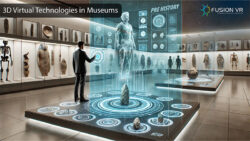Person (Mr. Kapoor): I have been hearing so much about virtual tours for museums, and I’m intrigued but also a bit skeptical. Can you help me understand how these work and if they are worth incorporating into my project?
Priya, Digital Museum Expert: Of course, Mr. Kapoor. Virtual tours are essentially a digital gateway to your museum. They are immersive experiences created using 3D modeling, high-resolution photography, and sometimes even augmented and virtual reality technologies. These tours allow people to explore your museum remotely, using a computer, smartphone, or VR headset.
Arjun, Digital Museum Expert: And it’s not just about recreating your museum digitally. Virtual tours can add layers of interactivity and storytelling. Imagine a visitor clicking on an ancient artifact to watch a holographic recreation of how it was made or its role in history. That’s the kind of magic we’re talking about.
Person (Mr. Kapoor): That does sound impressive. But isn’t it a bit risky? Won’t virtual tours make people less likely to visit the museum in person?
Priya, Digital Museum Expert: Not at all. In fact, it’s quite the opposite. Virtual tours often act as teasers, sparking interest and encouraging people to visit in person to experience the full exhibit. Think of it as a trailer for a movie it excites the audience and draws them in.
Arjun, Digital Museum Expert: And let’s not forget accessibility. Virtual tours allow you to reach people who might never be able to visit physically. Whether its students from another country, researchers, or people with mobility challenges, virtual tours expand your audience significantly.
Person (Mr. Kapoor): That’s impressive. But I’m starting from scratch. How do virtual tours fit into a museum’s overall design?
Priya, Digital Museum Expert: Great question. Virtual tours should be integrated into the museum’s design from the outset. When we plan your physical exhibits, we simultaneously develop their digital counterparts. This ensures a cohesive narrative and experience across both platforms.
Arjun, Digital Museum Expert: For instance, if you are planning an exhibit on ancient architecture, we can use photogrammetry to create detailed 3D models of the artifacts. These models can then be used in the virtual tour, offering visitors an up-close view they might not get even during a physical visit.
Person (Mr. Kapoor): What about the technologies involved? Can you explain what goes into creating these virtual tours?
Priya, Digital Museum Expert: Of course! Depending on the project’s scope, we utilize a blend of cutting-edge technologies. For instance, we use 360-degree photography and also create 180-degree VR videos and trailers to provide immersive views of spaces. Through 3D modeling and photogrammetry, we recreate artifacts and exhibits with exceptional detail. To make the experience more engaging, we integrate augmented reality (AR) elements, such as interactive hotspots that reveal animations or additional information, creating a truly immersive museum experience.
Arjun, Digital Museum Expert: On the backend, we use platforms compatible with VR headsets, desktops, and mobile devices. This ensures your virtual tour is accessible to a wide range of users. We also include analytics tools to track user engagement and gather insights on which exhibits resonate the most.
Person (Mr. Kapoor): Sounds like a significant investment. How do I justify the cost?
Priya, Digital Museum Expert: Think of it as an investment in accessibility and longevity. Virtual tours make your museum available 24/7 to a global audience. They’re also a great way to preserve your exhibits digitally, ensuring they’re accessible for future generations.
Arjun, Digital Museum Expert: And the ROI goes beyond ticket sales. Virtual tours can attract sponsorships, collaborations with educational institutions, and even grants for digital innovation. Plus, they are an excellent marketing tool to generate buzz and reach audiences you might not have tapped into otherwise.
Person (Mr. Kapoor): That’s a good point. Speaking of education, how do virtual tours contribute to learning?
Priya, Digital Museum Expert: Virtual tours are fantastic for education. We can integrate interactive elements like quizzes, timelines, and multimedia content to make learning more engaging. For example, a tour of an ancient civilization exhibit could include a 3D animation showing how the civilization evolved over centuries.
Arjun, Digital Museum Expert: And for younger audiences, gamified elements can turn the tour into an adventure. Imagine a treasure hunt where kids solve riddles to uncover the history of an artifact. This kind of interactive learning is not only fun but also memorable.
Person (Mr. Kapoor): This all sounds great, but how do I ensure the virtual tour stays relevant and functional over time?
Priya, Digital Museum Expert: Maintenance is key. We offer comprehensive support packages that include regular updates to the content and technology. Whether it’s adding new exhibits, upgrading features, or addressing technical issues, we’ve got you covered.
Arjun, Digital Museum Expert: We also future-proof the tour by designing it to be compatible with emerging technologies. As new devices and platforms become popular, your virtual tour can easily adapt.
Person (Mr. Kapoor): One last question. How do you ensure the virtual experience aligns with my vision for the museum?
Priya, Digital Museum Expert: Collaboration is at the heart of what we do. From the initial consultation to the final product, we work closely with you to ensure the virtual tour reflects your vision and objectives. Your input shapes every aspect, from the design and content to the interactive features.
Arjun, Digital Museum Expert: And we will walk you through every step of the process, ensuring you’re as involved as you want to be. Our goal is to create a virtual tour that not only meets but exceeds your expectations.
Person (Mr. Kapoor): Thank you, Priya and Arjun. This conversation has been incredibly insightful. I’m excited about the possibilities and can’t wait to get started.
Digital Museum Experts (in unison): We’re thrilled to help bring your vision to life!





